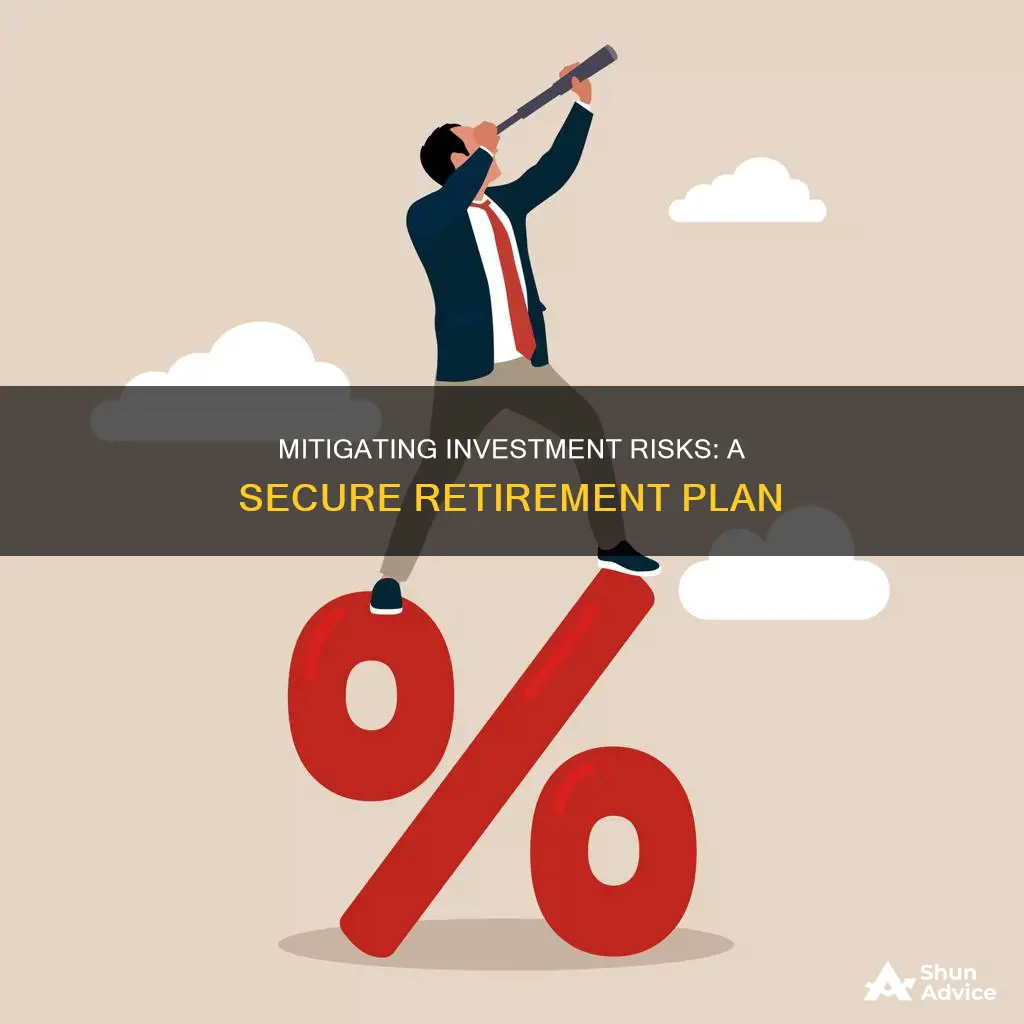
Retirement planning is a complex process that requires careful consideration of various factors. One of the critical aspects is understanding and addressing the risks involved in investing for retirement. These risks can significantly impact an individual's long-term financial security and the effectiveness of their retirement plan. This article will delve into the key investment risks that individuals face when planning for retirement and provide insights into strategies for mitigating these risks to ensure a more secure financial future.
| Characteristics | Values |
|---|---|
| Outliving your money | Think about delaying the age at which you claim Social Security. |
| Find out whether an annuity might be appropriate for you. | |
| Changes in markets | Take a second look at the way you invest. |
| Draw down your assets thoughtfully. | |
| Consider investments that could grow along with inflation. | |
| Rising medical expenses | Plan early for long-term care costs. |
| Consider a health savings account (HSA). | |
| Sequence of returns risk | Develop a strategy that avoids drawing down principal at the beginning of retirement. |
| Capitalize on a more favorable interest rate environment. | |
| Adopt a "bucketing" approach to your retirement savings. | |
| Taxes on retirement income | Limit the tax hit on distributions. |
| Overspending | |
| Investing too conservatively | |
| Veering away from your plan |
What You'll Learn

Plan for living longer than expected
People are generally living longer than previous generations, thanks to advances in medical science and healthier lifestyles. This is great news, but it also means that there is a very real possibility that you might outlive your retirement assets. In fact, according to a survey by the TIAA Institute and the Global Financial Literacy Excellence Center, 31% of people underestimate the life expectancy of a 65-year-old in the US.
- Plan for income beyond your life expectancy: Even if you live longer than the actuarial tables predict, ensure your retirement income continues beyond that timeframe. This can be achieved by not counting any funds you plan to leave as a legacy and instead planning for your non-guaranteed retirement income to extend well beyond your life expectancy. If it appears you might outlive this age, you can make adjustments as needed. While the ideal age to target will depend on your personal circumstances, a conservative approach would be to plan for a lifespan of 100 years.
- Build a retirement income buffer: Inflation can negatively impact your standard of living in retirement, especially if you're on a fixed income. To mitigate this risk, build a buffer into your retirement income projections. For example, if you estimate that $6,000 per month will cover your expenses, aim to save enough to generate $7,000 per month. This buffer will help maintain your purchasing power and provide flexibility if your costs are higher than expected.
- Continue seeking growth in your investments: While it's generally recommended to invest more conservatively during retirement, don't neglect growth entirely. Placing a portion of your retirement savings in growth investments can help offset inflation and ensure your savings keep pace with the rising cost of living.
- Consider investment vehicles with guaranteed lifetime payouts: Transfer the risk of living longer than expected to the entity sponsoring the payouts by investing in products like annuities. These can provide a steady stream of income for life and protect against the risk of outliving your savings. Consult a financial advisor to weigh the pros and cons of such investments, as they may come with certain costs and risks.
Entry-Level Investment Bankers: Long Hours, High Rewards
You may want to see also

Mitigate rising healthcare costs
Rising healthcare costs are a major concern for retirees and pre-retirees alike. Healthcare is expected to be one of the largest expenses in retirement, and unlike previous generations, most people will not have access to employer- or union-sponsored retiree health benefits. This means that healthcare costs will likely consume a larger portion of your retirement budget.
Plan ahead for long-term care costs
Long-term care costs can be significant, and it's important to plan for them in advance. Some people may be able to pay for long-term care out of pocket or rely on family members for assistance. However, for many others, long-term care insurance may be necessary. It is recommended to purchase this type of insurance in your 50s, as the cost rises as you age and it may not be available if you develop certain medical conditions.
Consider a health savings account (HSA)
An HSA is a tax-efficient way to save for healthcare costs in retirement. If you have an HSA-eligible health plan, you can contribute pre-tax dollars, which can grow over time and be withdrawn tax-free for qualified medical expenses. HSAs also allow you to carry over balances from one year to the next.
Understand Medicare options
Medicare is a critical component of healthcare coverage for retirees aged 65 and older. It is important to understand the different parts of Medicare (Parts A, B, C, and D) and the associated costs. Part A covers hospital costs, while Part B is optional coverage for medical expenses and requires an annual premium. Part C, or Medicare Advantage, is offered by private insurance companies, and Part D covers prescription drugs. There are also supplemental insurance policies, such as Medigap, that cover expenses not typically covered by Medicare Parts A and B.
Explore other coverage options
If you are under 65 and considering retirement, you may be able to take advantage of COBRA coverage or a retiree medical plan from your previous employer. If your spouse is still working, you may also be able to get coverage through their employer's plan. Part-time employment that offers health benefits could be another viable option to consider.
Invest in stocks or real estate
Inflation can reduce your spending power over time, and healthcare costs are particularly vulnerable to inflation. To mitigate this risk, consider investing in stocks or real estate, which have the potential to grow along with inflation. Treasury Inflation-Protected Securities (TIPS) are another option, as these government bonds offer returns that vary with the inflation rate.
By implementing these strategies and seeking advice from a financial advisor, you can better prepare for rising healthcare costs in retirement and protect your financial security.
Smart Investment Strategies: Where to Begin?
You may want to see also

Protect against market volatility
Market volatility can be a major threat to your retirement plans. Here are some strategies to protect your retirement savings from market volatility:
Maintain the Right Portfolio Mix
Diversifying your portfolio is crucial to mitigating risk. While some investors believe that having their savings in a mutual fund is enough, it's important to employ two types of diversification: asset allocation and diversification within each asset category.
Asset allocation involves determining the amount of each asset class you own, such as stocks, bonds, or cash equivalents. As you get closer to retirement, reduce your exposure to riskier holdings like small-cap stocks, as they tend to be more volatile than high-grade bonds or money market funds.
Within each asset category, aim for a balance between large-cap and small-cap stocks, and between growth and value funds. Most advisors also suggest having some international funds in your portfolio to cushion the impact of a US economic slump.
Have Some Cash on Hand
Financial planners recommend that retirees hold on to some stocks to protect against outliving their assets. However, retirees need to be more cautious due to their shorter time horizon. To safeguard against economic downturns, consider keeping up to five years' worth of expenses in cash or cash equivalents, such as short-term bonds, certificates of deposit, and Treasury bills.
Having cash on hand becomes crucial when unexpected big expenses arise during retirement. By having liquid assets, you can avoid the need to withdraw money from your investments when they have temporarily dropped in value due to market conditions.
Be Disciplined About Withdrawals
It's important to be mindful of your withdrawal rate to ensure the sustainability of your retirement funds. Most experts recommend withdrawing no more than 3% to 5% of your funds in the first year of retirement, and then adjusting your annual withdrawal rate to keep pace with inflation.
Withdrawing too much of your retirement assets early on can lead to poor investment decisions driven by desperation. Planning your withdrawal allowance helps you avoid the need to liquidate a large sum of assets at low prices to cover your living expenses.
Don't Let Emotions Take Over
Resist the urge to make impulsive decisions when the market becomes volatile. Avoid panic-selling during stock market volatility, as you may miss out on investment gains once the market recovers. Instead, stay the course and maintain a steady hand, whether the market is struggling or booming.
Consider "Time-Segmented Bucketing"
This strategy involves aligning your assets with the early, middle, and late stages of retirement. Invest assets for your short-term needs early in retirement conservatively, so market volatility is less of a concern as you make withdrawals. Meanwhile, invest assets for your future spending needs or gifting plans more aggressively for potential growth.
Consider an Annuity
Annuities provide a reliable stream of income that may eliminate the need to sell portfolio assets during market stress. They offer a set amount of income for life, ensuring you don't outlive your savings. Variable annuities and fixed-index annuities provide exposure to potential equity-market growth and may offer higher payout rates than other investments.
Invest for Income
Consider investing in investment-grade bonds and dividend-paying stocks to collect regular income and support your spending needs. This approach allows you to leave the principal investments untouched, at least until the market recovers. However, be aware that some companies may reduce or suspend dividend payments during extended periods of market volatility.
Focus on Tax-Efficiency
Carefully manage your withdrawals from taxable, tax-exempt, and qualified tax-deferred accounts to minimize the tax impact. Distributions from qualified retirement plans, such as a 401(k) plan, and traditional IRAs are considered ordinary income by the IRS.
One strategy is to take advantage of income-smoothing techniques. If you're over 59 1/2, consider taking distributions from tax-advantaged accounts before they are required to lower account balances and potentially reduce the tax burden when you reach the age of mandatory withdrawals.
Understanding Annual Investment Reports: A Guide to Smart Investing
You may want to see also

Diversify your investment portfolio
Diversifying your investment portfolio is a key strategy to address investment risks in your retirement plan. Here are some detailed tips to help you diversify effectively:
Understand the Basics of Diversification
Diversification is the concept of spreading your investments across different types of assets to reduce risk. By investing in multiple areas, you decrease the potential downside of any single investment affecting your overall portfolio value. This is often referred to as "spreading your eggs among many baskets".
Diversify Across Different Asset Classes
Asset classes include stocks, bonds, funds, real estate, and certificates of deposit (CDs). Historically, stocks have offered higher returns but come with higher risk. On the other hand, fixed-income investments like bonds provide lower returns but are less volatile. A balanced portfolio should include a mix of these asset classes.
Diversify Within Each Asset Class
Within each asset class, you can further diversify. For example, with stocks, you can invest in different sectors like technology, healthcare, consumer staples, etc. You can also diversify by market caps (large, mid, or small), business size (corporations, regional companies, startups), and geographic location (domestic or international companies).
Consider Index Funds and Mutual Funds
An easy way to diversify your portfolio is to invest in index funds, such as the S&P 500, which tracks a broad range of stocks. Mutual funds or exchange-traded funds (ETFs) are also great options as they automatically diversify your holdings by investing in multiple assets.
Diversify Your Fixed Income
When it comes to fixed-income investments, consider short- and mid-term bonds, which can generate higher returns faster than long-term bonds. Look for bonds that cover multiple sectors, such as government, municipal, corporate, and mortgage-backed securities. You can also explore alternative investments like gold, hedge funds, real estate, and collectibles.
Be Mindful of Over-Diversification
While diversification is beneficial, be careful not to over-diversify your portfolio. Too many investments may result in average returns and can make your portfolio resemble an index fund. Be strategic and purposeful in your diversification choices, ensuring they align with your risk tolerance and financial goals.
Remember, diversification is a powerful tool to manage risk and enhance your retirement fund's stability. By following these tips and regularly reviewing your portfolio, you can better prepare for a comfortable retirement.
Investing in New York's 529: A College Savings Guide
You may want to see also

Understand your risk tolerance
Understanding your risk tolerance is a crucial aspect of addressing investment risks in your retirement plan. It involves assessing how much fluctuation or volatility you are comfortable with in your savings journey. Here are some detailed insights to help you understand your risk tolerance:
Factors Influencing Risk Tolerance:
- Nature of Investments: The types of investments included in your portfolio significantly impact your risk tolerance. For instance, stocks are generally considered riskier but offer higher growth potential, whereas bonds and fixed-income investments are more conservative and stable.
- Time Horizon: Your time until retirement plays a crucial role in determining your risk tolerance. Younger investors with a longer time horizon can typically tolerate more risk as they have more time to recover from market downturns and benefit from the higher growth potential of riskier investments. As investors approach retirement age, they often reduce risk exposure to preserve their nest egg.
- Financial Circumstances: Your financial situation, including income growth prospects and desired lifestyle, influences your risk tolerance. If you anticipate significant income growth, you may be more inclined to take on riskier investments. However, if you plan to maintain a certain lifestyle in retirement, you might opt for a more conservative approach.
- Personality and Comfort Level: Risk tolerance is also influenced by your personality and comfort level with market volatility. Some individuals are naturally more risk-averse, while others are comfortable taking on higher risk for potential gains.
Assessing Your Risk Tolerance:
- Understanding Risk and Reward: Recognize that higher risk typically comes with the potential for higher returns. Assess whether you are willing to take on above-average risk for the possibility of above-average returns.
- Anxiety and Loss Aversion: Consider how anxious you feel about the potential loss of money in the stock market. Would you be tempted to sell your investments if they lost value over a year? Understanding your emotional response to market fluctuations is essential.
- Work Horizons: Evaluate how many years you plan to work before retiring. A longer time horizon may allow you to take on more risk, as you have more time to recover from potential losses.
- Financial Professional Guidance: Consult a financial professional or advisor to help you assess your risk tolerance. They can provide valuable insights, suggest products that fit your risk profile, and assist in creating a diversified retirement plan.
Remember, risk tolerance is highly individual, and there is no one-size-fits-all approach. It's crucial to understand your risk tolerance to make informed decisions about your retirement investments and ensure your savings strategy aligns with your comfort level and goals for the future.
Vanguard's Investment Manager Selection: The Key Criteria
You may want to see also
Frequently asked questions
People are generally living longer, which means there is a real possibility that you might outlive your retirement savings.
Consider delaying the age at which you claim Social Security. You could also look into investing in a lifetime income annuity, which could provide income for as long as you live.
Changes in the market. Even though markets tend to gain over time, there can be significant drops that can impact the value of your investments.
Take a look at the way you invest. You might want to shift to a more conservative investment approach while still maintaining some exposure to stocks.
It's important to start saving and investing for retirement as early as possible. You should also consider working with a financial professional to help you shape your risk philosophy and suggest products that fit within it.







